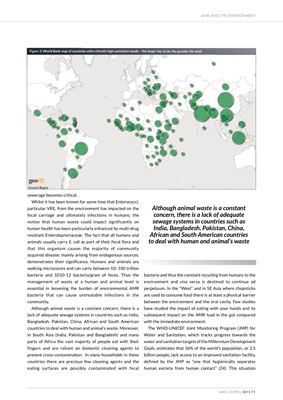
sewerage becomes critical.
Whilst it has been known for some time that Enterococci,
particular VRE, from the environment has impacted on the
fecal carriage and ultimately infections in humans; the
notion that human waste could impact significantly on
human health has been particularly enhanced by multi-drug
resistant Enterobacteriaceae. The fact that all humans and
animals usually carry E. coli as part of their fecal flora and
that this organism causes the majority of community
acquired disease; mainly arising from endogenous sources,
demonstrates their significance. Humans and animals are
walking microcosms and can carry between 10-100 trillion
bacteria and 1010-12 bacteria/gram of feces. Thus the
management of waste at a human and animal level is
essential in lessening the burden of environmental AMR
bacteria that can cause untreatable infections in the
community.
Although animal waste is a constant concern, there is a
lack of adequate sewage systems in countries such as India,
Bangladesh, Pakistan, China, African and South American
countries to deal with human and animal's waste. Moreover,
in South Asia (India, Pakistan and Bangladesh) and many
parts of Africa the vast majority of people eat with their
fingers and are reliant on domestic cleaning agents to
prevent cross-contamination. In many households in these
countries there are precious few cleaning agents and the
eating surfaces are possibly contaminated with fecal
bacteria and thus the constant recycling from humans to the
environment and visa versa is destined to continue ad
perpetuum. In the "West" and in SE Asia where chopsticks
are used to consume food there is at least a physical barrier
between the environment and the oral cavity. Few studies
have studied the impact of eating with your hands and its
subsequent impact on the AMR load in the gut compared
with the immediate environment.
The WHO-UNICEF Joint Monitoring Program (JMP) for
Water and Sanitation, which tracks progress towards the
water and sanitation targets of the Millennium Development
Goals, estimates that 36% of the world's population, or 2.5
billion people, lack access to an improved sanitation facility,
defined by the JMP as "one that hygienically separates
human excreta from human contact" (24). This situation
AMR AND THE ENVIRONMENT
AMR CONTROL 2015 71
Figure 3: World Bank map of countries with critically high sanitation needs - the larger the circle, the greater the need
Although animal waste is a constant
concern, there is a lack of adequate
sewage systems in countries such as
India, Bangladesh, Pakistan, China,
African and South American countries
to deal with human and animal's waste